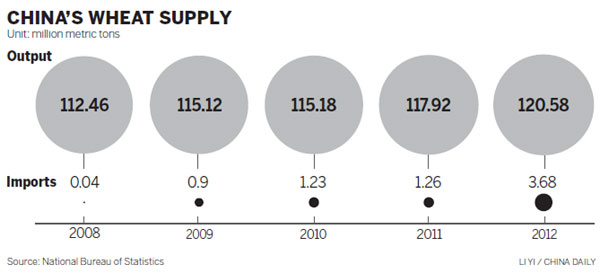Steady year seen for wheat imports despite dry weather
By Zhong Nan (China Daily) Updated: 2014-01-30 07:36
 |
There hasn't been much snow in winter wheat-producing regions of China over the past three-and-a-half months, and rainfall has only been about average. Still, the nation's imports aren't set to change much this year, industry experts said.
Winter wheat in China is usually planted between September and November, and harvested in the summer or early autumn of the following year.
The winter crop accounts for more than 90 percent of China's total wheat output.
The nation's main winter wheat-producing provinces include the provinces of Hebei, Shandong, Jiangsu, Anhui and Henan - all on the North China Plain - which account for 70 percent of total winter wheat production.
Other prime growing areas are Jiangsu and Anhui provinces in the Yangtze and Huaihe river valleys, respectively.
Total precipitation has been light in all of these areas this winter, according to the State Flood Control and Drought Relief Headquarters.
Ding Lixin, a researcher at the Chinese Academy of Agricultural Sciences in Beijing, said that current conditions in the North China Plain wouldn't harm the country's wheat output this year.
"After grappling with various extreme weather conditions for decades, China has implemented a number of measures.
"These include increasing supplementary irrigation facilities to compensate for the negative impact of [water shortages] to keep the staple food supply and demand in balance.
"The nation also provides timely allocations to support farmers' incomes and subsidize the costs of diesel, fertilizer and pesticide," said Ding.
To reduce the damage caused by drought in parts of the spring wheat-planting areas, China enlarged winter wheat production areas in the North China Plain and the Xinjiang Uygur autonomous region, among other steps.
- NHTSA says finds no 'defect trend' in Tesla Model S sedans
- WTO rare earth ruling is unfair
- Amway says 2014 China sales may grow 8%
- President Xi in Europe: Forging deals, boosting business
- CNOOC releases 2013 sustainability report
- Local production by Chery Jaguar Land Rover this year
- Car lovers test their need for speed in BMW Mission 3
- China stocks close mixed Monday

















